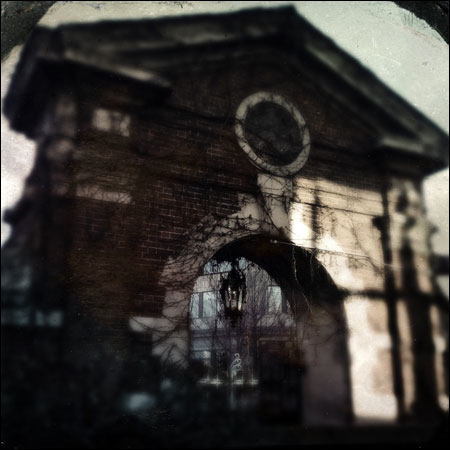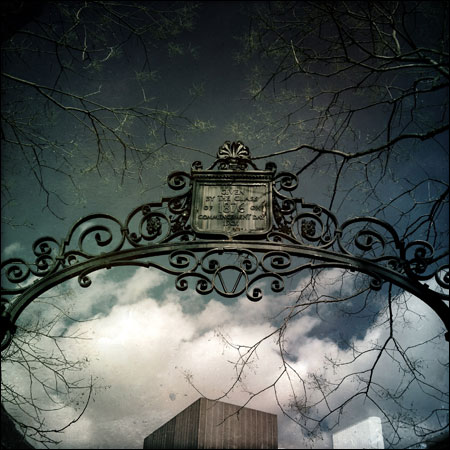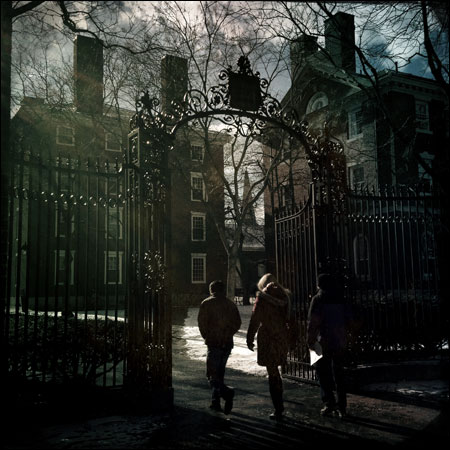
Photo by Finbarr O’Reilly
Blair Kamin, the Pulitzer Prize-winning architecture critic for the Chicago Tribune and a current Nieman Fellow, once described architecture—for better or worse—as the "inescapable art." One can avoid the play, film or restaurant a critic just trashed, he argued, but not our built surroundings.
And at Harvard nothing is as architecturally present as the iconic gates that surround the Yard. Kamin calls them "the architectural DNA" of the university. With "Rate the Gates," a one-week course that he co-taught at Harvard this past January, his aim was to instruct students how to think and write like a critic.
"In the Internet age, everybody, it would seem, is a critic because everyone has the capacity to express an opinion and post it on the Web, via a comment box or a blog. This shift presents a challenge to traditional critics from the pre-digital age. Why should their voice count more than other voices? Are they out-of-touch elitists? How should they assert authority?" said Kamin.



Harvard’s massive Bacon Gate, top, contrasts with the delicate ironwork of the Holworthy Gate, middle and above, a major entryway to the Yard. Photos by Finbarr O’Reilly.
Criticism starts with close scrutiny. On the first day of class, Kamin took the students on a tour. "Just stop a second and look at the play of light on this floral medallion and imagine someone getting this piece of wrought iron and hammering that out," said Kamin, gazing up at the Class of 1886 Gate on the northwestern edge of the Yard.
A foundation of facts must be amassed before a strong critique can be built. "The story does not start with you," Kamin told the students that first day in preparation for the two essays they were required to write for the course. Research begins with old-fashioned digging, he instructed them, not only for backstories that help breathe life into the writing, but also as a way to understand the design ideas behind architecture. "Don't just review the gate," Kamin wrote in a message to the class. "Review the idea behind the gate. That's the substance of criticism."
Melissa Simonetti, a graduate student of design at Harvard, wrote in her essay on the Class of 1877 Gate, also known as the Morgan Gate, next to Widener Library, that it appears too grand for its location on a busy hub of Massachusetts Avenue. In her research she discovered why: Architects originally planned a boulevard leading from the Charles River to the Yard. She put that incongruity into perspective in her essay, comparing it to viewing Berlin's Brandenburg Gate without the Unter Den Linden, the graceful boulevard that leads to it. Simonetti's essay adhered to what Kamin told the class: "Your job is to minimize description and maximize observation."
In teaching about observation, Kamin noted that architecture critics don't just observe with their eyes. They use their ears to listen to the users of buildings and learn how they interact with the space, sometimes in unexpected ways.
Two fellow Niemans from the 2013 class co-taught with Kamin. Finbarr O'Reilly, a Reuters photographer, taught students about composing photos of the gates that accompanied their essays. These critiques were written with the help of Jeneen Interlandi, a magazine writer and the class writing coach.
Kamin engages in "activist criticism," a term coined by Allan Temko, the late Pulitzer-Prize winning architecture critic at the San Francisco Chronicle. Temko disparaged an America being ruined, he said, by strip malls and soul-less subdivisions. Known for his acid-pen descriptions of structures he loathed, he managed to force the hand of city officials and architects to redesign, as Kamin once noted, "everything from Bay Area bridges to cathedrals to office buildings."
Kamin described to students how in his own work he, like Temko did, evaluates building plans long before construction starts. "In other words," he said, "before it's too late." The watchdog role, as someone who "protects the public," is an important one for a critic, he said. In fact, he added, there is a long line of activist architecture critics who made bold calls and influenced how cities look and work as public spaces. Foremost among these is the late Ada Louise Huxtable, who in 1970 won the first Pulitzer Prize awarded for criticism.
Kamin's most controversial columns centered on Chicago's Lakefront, what he calls "the sacrosanct point of pride in the city." In a 1998 series of articles, he linked the decrepit swaths of the Lakefront with a policy of neglect in areas that were mostly poor and black. And those articles certainly lit political fires.
Some 15 years after the series was published and after the years of pestering and prodding that followed, there has been an investment of millions of dollars and dramatic changes, with a brand-new marina, restaurants, playgrounds and better bike paths. "It's now what it should be, a mixing chamber where people of different backgrounds can share the same space, something rare in our increasingly polarized world," Kamin said.
He was an outspoken critic of the renovation of Soldier Field stadium, home of the Chicago Bears, from the early debate about the plan to the project's completion in 2003. He derided plans to put a tall modern seating bowl inside the classical building, arguing that it would be out of character and out of scale with its surroundings. He suggested the stadium be built elsewhere and in the process got his share of hate mail.
Colorful writing is part of a critic's arsenal and in Kamin's battle to halt the stadium's reconstruction he came up with some entertaining names for the project including, "The Eyesore on the Lake Shore" and "Klingon meets Parthenon." While he lost the war to stop the stadium, he won a smaller battle when the federal government stripped the new Soldier Field of its National Historic Landmark status.
Heeding the class lesson that arts criticism must be forcefully and passionately written and with an eye to change, Lily Sugrue, a 19-year-old freshman, offered a compelling argument for the reopening of the Class of 1870 Gate, which has long been locked. She compared it to the locked portal of Frances Hodgson Burnett's children's classic, “The Secret Garden”: "It is the gate that could use a little Mary Lennox of its own to breathe some life back into it."
Sugrue's call to open the gate along with other student suggestions have been sent for Harvard officials to review. Their careers as activist critics have begun.
 Dina Kraft, a 2012 Nieman Fellow, is a recovering foreign correspondent, based most recently in Tel Aviv.
Dina Kraft, a 2012 Nieman Fellow, is a recovering foreign correspondent, based most recently in Tel Aviv.



